Congratulation! You find the right article if you’re looking for the best AfterShip alternative for your business.
AfterShip is undeniably an industry-leading eCommerce solution. It offers a wide range of products, including shipment tracking, returns management, AI-powered delivery predictions, email and SMS marketing, multi-carrier shipping management, and more.
People have all kinds of reasons to like AfterShip, and just as many reasons to dislike it.
We will discuss the main complaints customers have about AfterShip and recommend 10 great AfterShip alternatives! Read on to find out more!
Why do Businesses Look for AfterShip Alternatives?
We collected real user experiences of AfterShip from major review platforms, including G2, Capterra, and Trustpilot.
Then we found that most negative feedback centers on four main issues: being billed for features that don’t work, unreliable shipment tracking, poor customer support, and integration difficulties.
Below is a summary of each issue and their prevalence among AfterShip’s negative reviews.
| Reason why businesses dislike AfterShip? | Level of User Complaints (Stars) |
| Get billed for features that don’t work | ★★★★☆ |
| Unreliable shipment tracking | ★★★★☆ |
| Poor customer support | ★★★☆☆ |
| Integration difficulties | ★★★☆☆ |
| Other issues | ★★☆☆☆ |
#1 Get Billed for Features that don’t Work
Some users reported being charged even when certain features were not functional or the service could not be put into production, and the refund process was often difficult.

#2 Unreliable Shipment Tracking
Some users mentioned that tracking information was not updated in a timely manner, or that support for certain international carriers was inadequate.
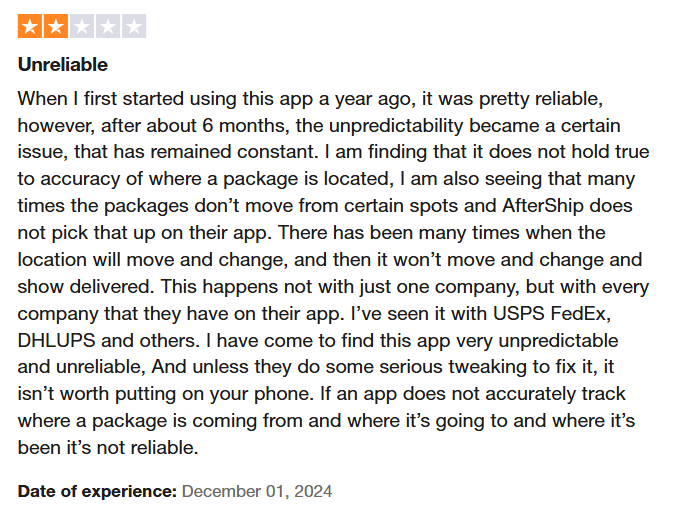
#3 Poor Customer Service
While many users praised the customer service for being responsive and friendly, others stated that when faced with complex issues or billing disputes, support was unable to provide effective solutions.
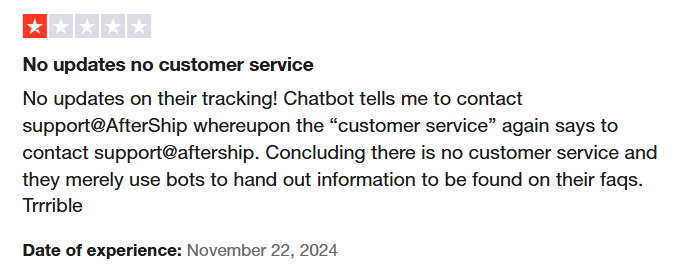
#4 Integration Difficulties
For some non-technical users or businesses needing to connect multiple platforms, the integration process was hampered by unclear documentation and complicated setup procedures.
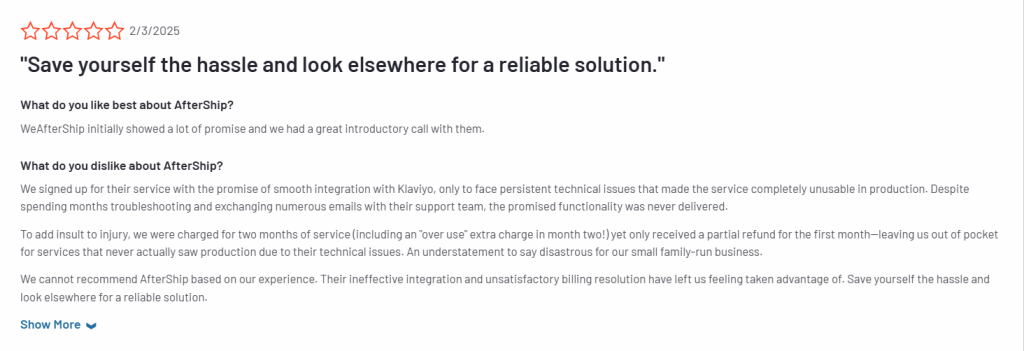
#5 Other Issues
Some users have also complained about unexpected price increases, a lack of flexible pricing plans for small businesses, limited carrier tracking options, and occasional compatibility problems with certain eCommerce platforms.
It’s fairly expensive for send over 100 packages per month. SMS is sort of expensive feature, but handy to have though. – G2 Review
Prices are very high for some features that in our opinion should be more affordable. We spend about 15 dollars for 150 shipments each month, but we can’t use multi-language E-Mails for example that should be a default option, because it’s not included in our plan. The superior plan that include this feature cost about 90 dollars, but with a very high number of shipment that we do not need. So we hope that they will can be more close to customers in that sense. – G2 Review
Sometimes tracking don’t update or break. Also there are a few foreign postal carriers that my users would like to use and AfterShip hasn’t implemented them. – Capterra Review
These issues have led many businesses to look for alternatives to AfterShip. Now is the perfect time for you to take action. Explore our list of the top 10 AfterShip alternatives that we highly recommend and find the best one for your business.
5 Considerations When Choosing AfterShip Alternatives
Though we recommend 10 AfterShip alternatives, ask yourself these 5 questions to find the best one for your business.
1. What’s Your Budget and Pricing Structure Preference?
Budget conversations aren’t fun, but they’re always the first element when you’re making a choice.
Different providers use completely different pricing models. Some charge per shipment, others have flat monthly rates, and many mix both approaches.
Watch out for the scaling trap. That cheap per-shipment rate looks great when you’re processing 100 orders monthly. But what happens when you hit 5,000 or 10,000 orders? Suddenly, your tracking costs become a major line item.
Consider solutions with predictable pricing that won’t punish your success. Flat-rate or tiered pricing often works better for growing businesses.
2. What Main Feature does Your Business Need?
Every business faces different challenges. For example, your main concern might be keeping customers engaged after they make a purchase. Another company might struggle with providing clear shipment visibility to their customers.
So, identifying your unique pain points first. Once you understand what problems you need to solve, you can select software with the right features to address those specific issues.
Don’t get distracted by flashy features you don’t actually need. Instead, focus on finding a solution that directly tackles your biggest operational challenges.
3. Do You Need Advanced Analytics and Insights?
Some businesses just need basic “where’s my package” functionality. Others want deep insights into their shipping performance.
Ask yourself these questions: Do you need to compare carrier performance? Want to identify delivery bottlenecks? Curious about customer behavior after they receive tracking info?
If you answered yes, basic tracking won’t cut it. Look for platforms that turn your shipping data into actionable insights. The right analytics can help you spot problems before customers complain and optimize your entire fulfillment process.
4. How Important Is Customer Support Quality to Your Business?
When something goes wrong with tracking, you need help fast. Your customers are waiting, and every minute counts.
Here’s what to consider: Does the provider offer 24/7 support? Can you reach a real person when you need help? How quickly do they respond to technical issues?
Some businesses can handle occasional hiccups with basic email support. Others need immediate phone support when tracking systems go down. Know which camp you’re in before making a decision.
5. Do You Have A Tech Stack to Develop the Solution?
Here’s the reality: even with a tech team, making the solution more customized to your business eats up tons of time.
Think about this: If you work with multiple shipping carriers, each one uses different terms for the same delivery status. What one calls “delivered,” another might call “completed” or “package received.”
We’ve all been there, right? You end up spending weeks just trying to make sense of all these different status names. Yes, it’s way more complicated than it sounds.
Read the following content, and you will find the perfect AfterShip alternative for your business!
Top 10 AfterShip Alternatives & Competitors [2025]
Discover the top 10 AfterShip alternatives and competitors for 2025. Simply click the logo in the first column to explore more details about each alternative.
| Platform | Best for | Learn more |
|---|---|---|
| Growing eCommerce businesses wanting cost-effective tracking with professional branded experience | → | |
| | Large retailers (100k+ orders/month) needing advanced post-purchase automation and customer intelligence | → |
| Sustainability-focused brands wanting to offer shipping protection while reducing environmental impact | → | |
| Mid-to-large brands prioritizing customer engagement and retention through personalized delivery experiences | → | |
| Data-driven businesses needing detailed logistics performance insights and carrier optimization | → | |
| Shopify store owners wanting seamless integration with built-in marketing opportunities | → | |
| Retailers with both online and offline presence needing unified order management across channels | → | |
| Businesses shipping primarily in India/South Asia requiring local carrier expertise and COD handling | → | |
| High-volume shippers (500+ orders/month) needing efficient label creation and order processing | → | |
| European businesses requiring international shipping expertise and customs documentation | → |
Let’s have a deep learning into these AfterShip alternatives and competitors!
1. TrackingMore
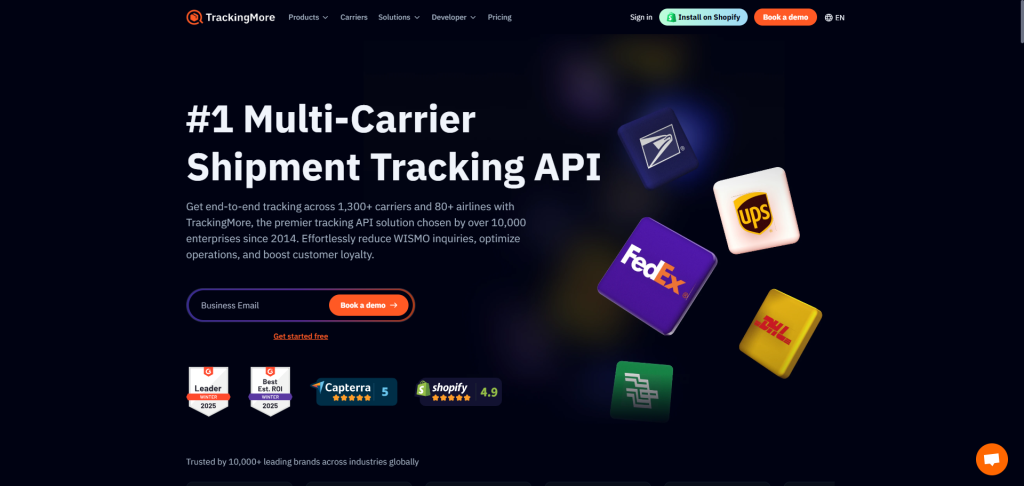
G2: 4.7/5
Starting price: $11/month
TrackingMore is the best AfterShip alternative if you need a solid shipment tracking solution.
TrackingMore has been developing a shipment tracking API for over 10 years and knows the tracking needs of each kind of business, including eCommerce merchants, marketplaces, logistics companies, finance agencies, and software service providers.
Whether you are looking for more accurate and reliable shipment tracking or want a specialized post-purchase solution for your eCommerce business, TrackingMore can help you out.
Compared to Aftership, TrackingMore is better priced, with the basic plan allowing you to track more shipments. Additional items also cost less to track on TrackingMore after you exhaust your quota. TrackingMore comes with a 14-day free trial that lets you use premium features; this offer is not available with AfterShip.
Key Products
- Shipment dashboard: allows you to have a clear view of all your shipments. You can easily monitor delivery statuses, identify delays, and manage exceptions from a single intuitive interface.
- Multi-carrier tracking API: with TrackingMore’s robust tracking API, you can retrieve real-time shipment tracking data from over 1,400 carriers worldwide.
- Tracking webhook: receives instant notifications automatically whenever your package status changes. Ideal for businesses managing time-sensitive shipments.
- Branded tracking page: provides your customers a branded self-service portal to track packages, reducing support inquiries.
- Automated shipping notification: keeps your customers informed with timely email and SMS alerts throughout the shipping journey automatically.
- Air cargo tracking: tracks the shipment statuses of over 80 major airlines via one unified dashboard and API.
Pros
- Shipment tracking solution built on in-house API
- Great tracking network of 1,400+ carriers and 80+ airlines globally
- Low priced with comprehensive tracking features
- A 14-day free trial with full access to premium features
- Developer-friendly with detailed API documentation and SDKs
- 24*7 customer support and a dedicated account manager
Cons
- Limited shipping services
- Limited integration with other platforms or software
2. Narvar
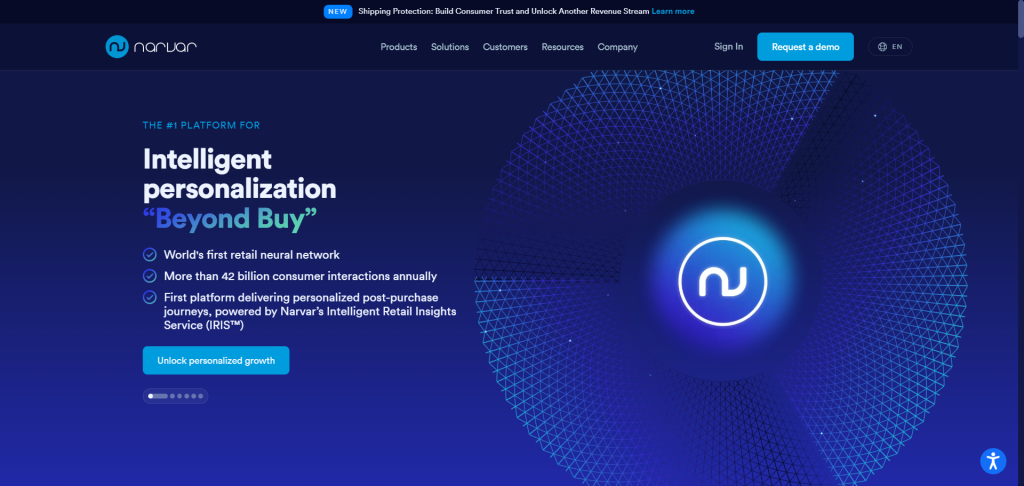
G2: 4.3/5
Starting price: contact sales
Powered by Intelligent Retail Insights Service (IRIS™), Narvar analyzes billions of data points to create post-purchase experiences that improve customer satisfaction and drive sustainable business growth.
Compared to AfterShip, Narvar is more dedicated to post-purchase customer experience solutions.
Key Features
- AI-powered returns and exchange management: empowers retailers to configure personalized return policies and streamline reverse logistics.
- Personalized tracking experience: customizes tracking pages and keeps customers informed with proactive delivery notifications.
- AI estimated delivery claim: automates delivery claims management to detect fraud and reduce the burden on resources.
- Proactive communication with customers: offer 40+ purpose-built messages to craft highly engaging consumer journeys.
Pros
- AI-powered system
- Comprehensive post-purchase solution
Cons
- Limited support for international users
- Unclear pricing plans
- No public technical documentation
3. Route
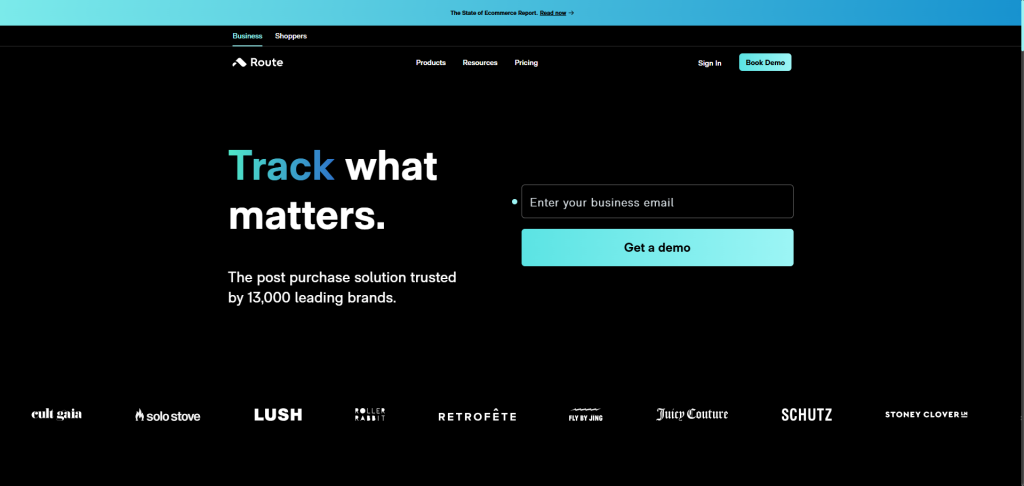
G2: 4.5/5
Starting price: $349/month
Route is an order tracking app that lets you and your customers track, deliver, and protect orders.
Route is a good AfterShip competitor if you’re looking for an environmentally friendly order tracking solution.
Key Features
- Shipping protection: protects your customers’ orders against loss, theft, or damage.
- Package tracking: offers an immersive package tracking experience for your customers.
- Product recommendations: deliver hyper-relevant product recommendations that convert.
- Carbon-neutral shipping: automatically included every time your customer selects the shipping protection option at checkout.
Pros
- Visual package tracking for customers
- Neutralize shipping emissions for each order
Cons
- Expensive starting price
4. parcelLab
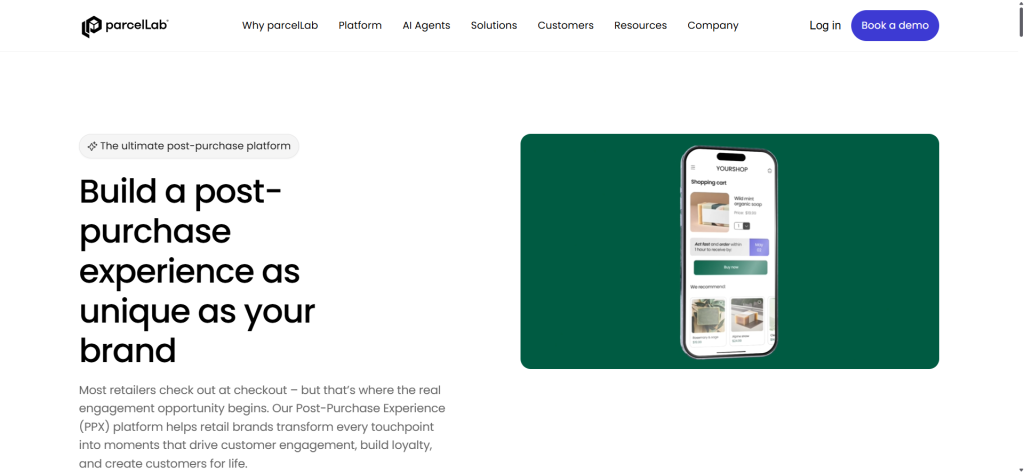
G2: 4.7/5
Starting price: contact sales
parcelLab is a leading post-purchase experience platform tailor-made for online stores. The platform offers smart tools to enhance communication and interaction with customers.
Compared to AfterShip, parcelLab focuses more on creating branded customer experiences.
Key Features
- One connected platform: handles delivery promises, fraud protection, order tracking, and returns in a single integrated system.
- Automation: offers automatic order status updates, exception alerts, and delivery delay notifications that eliminate manual tracking work.
- Insights: provides actionable shipping analytics that measure carrier performance, personalize customer experiences, and drive business growth through data intelligence.
Pros
- AI-powered tools
- Integrates with many tech stacks
Cons
- Limited carrier integration: 280+ carriers
- Unclear pricing plans
5. Parcel Perform
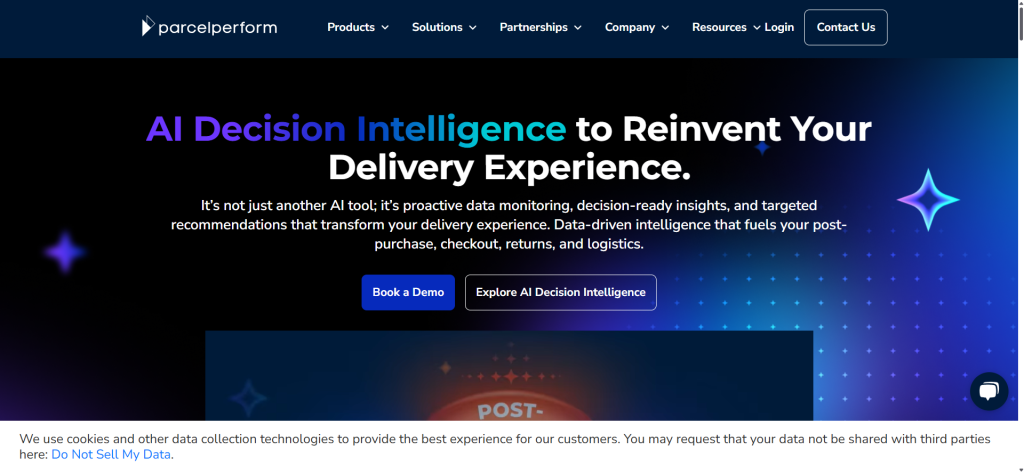
G2: 4.7/5
Starting price: contact sales
By leveraging AI-driven data, Parcel Perform empowers enterprise e-commerce businesses with mastery over the post-purchase process.
If your business requires in-depth logistics data analysis, you can consider using API-driven products like TrackingMore or software like Parcel Perform, which excels in data analytics capabilities.
Key Features
- Checkout experience: displays an accurate and clear estimated delivery date that boosts checkout conversions.
- Post-Purchase experience: provides a complete and real-time view of every order’s journey, even during delivery exceptions.
- Returns experience: offers self-service returns integrated into your website, policy automation, and refund alternatives such as exchanges.
- Logistics experience: Optimizes carrier selection and automates shipping invoice audits to reduce shipping costs.
- E-Commerce co-pilot: sets order aspirations, creates alerts, and builds data dashboards by using existing integrations with your OMS, WMS, and TMS.
Pros
- Unparalleled data infrastructure
- Great tracking network: 1,100+ carriers
Cons
- Steep learning curve
- Unclear pricing plans
6. ParcelPanel
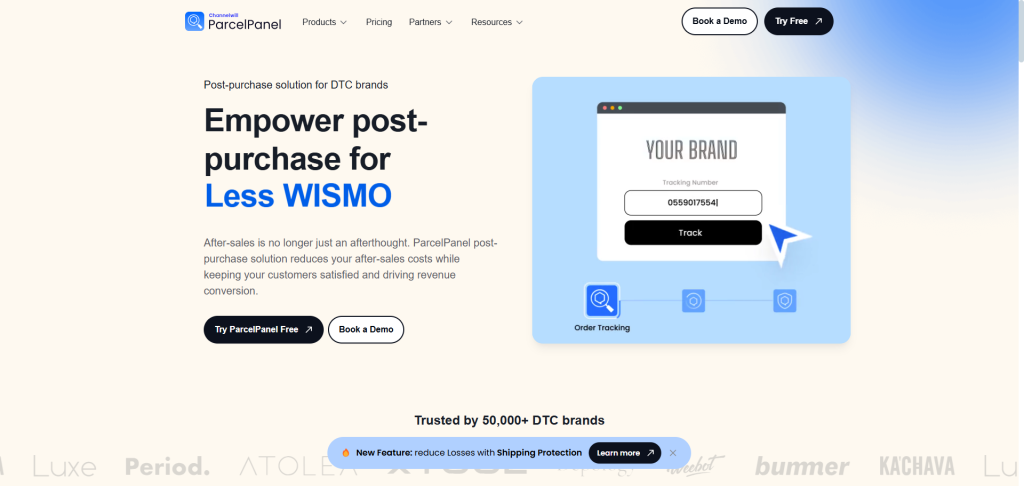
G2: 4.9/5
Starting price: $11/month
If your store is built by Shopify or WooCommerce, ParcelPanel is definitely your top choice.
ParcelPanel is the #1 order tracking app in the Shopify app store. It offers a complete post-purchase solution, including order tracking, shipping protection, and returns management.
Key Features
- Order tracking: delivers engaging brand order tracking experiences to reduce WISMO calls, foster customer loyalty, and drive sales.
- Shipping protection: protects your product against loss, damage, and delay; carbon-neutral shipping is also available.
- Returns & exchanges management: easily checks, processes your returns, and manages exchanges through a smart dashboard.
Pros
- Great tracking network: 1,400+ carriers
- Connected with 50+ apps
- A 7-day free trial with full access to premium features
Cons
- Limited fulfillment features
7. WeSupply Labs
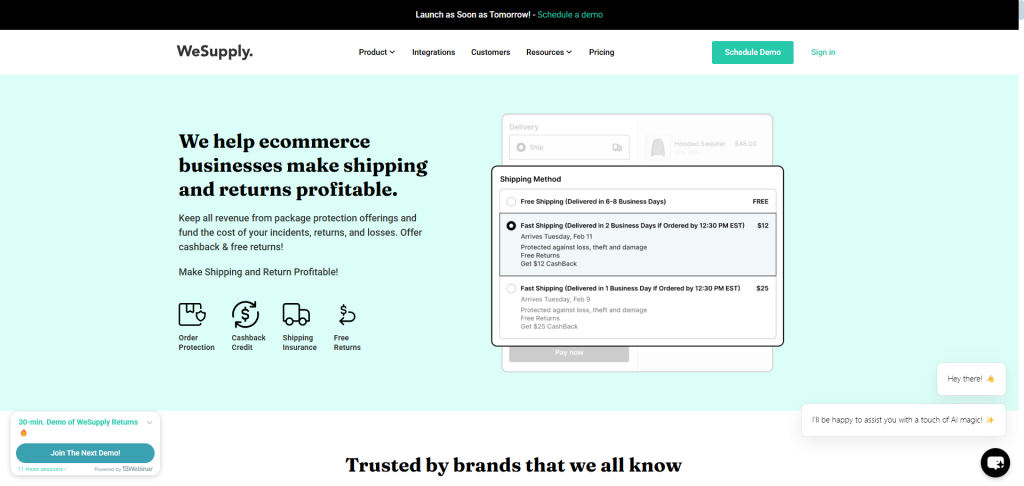
G2: 4.5/5
Starting price: $60/month
WeSupply Labs is a post-purchase experience platform that helps businesses unify their online and offline sales channels. Besides tracking, it also provides in-store and curbside pickup to streamline your shipping process.
Key Features
- Tracking and notifications: offers a basic branded tracking page and shipment tracking insights.
- Returns and exchanges: provides a self-service returns portal and a fully automated returns policy.
- In-store and curbside pickups: offers a shipping system that streamlines multiple channels into a single process.
Pros
- Great tracking network: 1,400+ carriers
- A 14-day free trial with full access to premium features
Cons
- The starting plan is expensive at $60 per month
8. ClickPost
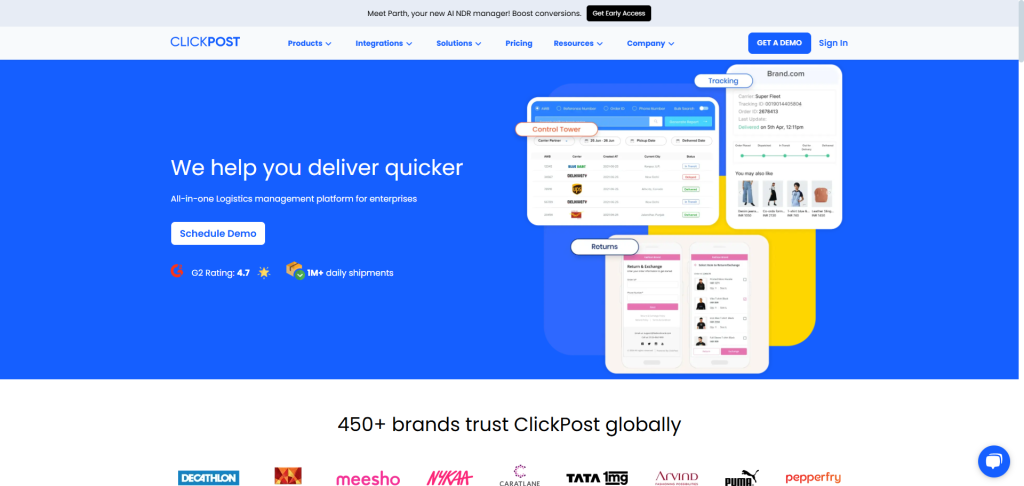
G2: 4.7/5
Starting price: contact sales
ClickPost is an all-in-one delivery management platform. It can streamline your logistics operations with automated shipping and tracking.
Key Features
- Logistics automation: automates many repetitive tasks within shipping management, inventory control, returns and exchanges, order creation, and more.
- Shipment tracking: offers branded tracking page, white-labeled notifications, and in-app tracking.
Pros
- All-in-one automated fulfillment software
Cons
- Limited carrier integration: 500+ carriers
- Unclear pricing plans
9. ShipStation
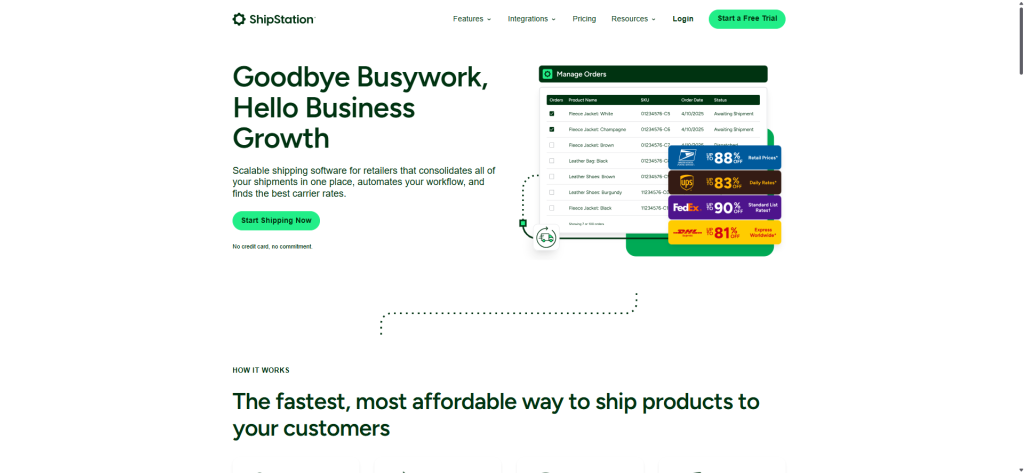
G2: 4.3/5
Starting price: $14.99/month
If you are looking for a more dedicated shipping software, ShipStation is an ideal choice. You can expect a mature fulfillment process, along with their advanced shipping management tools.
Key Features
- Shipping management: offers a range of shipping tools like label generation, shipping insurance, and access to discounted shipping rates.
- Omnichannel management: enables you to track every sale from all channels in a single place.
- Order management: lets you customize workflows and automate tasks to fulfill orders more efficiently.
- Inventory management: helps you monitor stock levels and prevent over- or under-selling by consolidating inventory data.
- Warehouse management: streamlines how you pack and prepare shipments, improving overall fulfillment operations.
Pros
- Flexible plan; friendly to small and medium businesses
Cons
- Poor customer support
10. ShippyPro
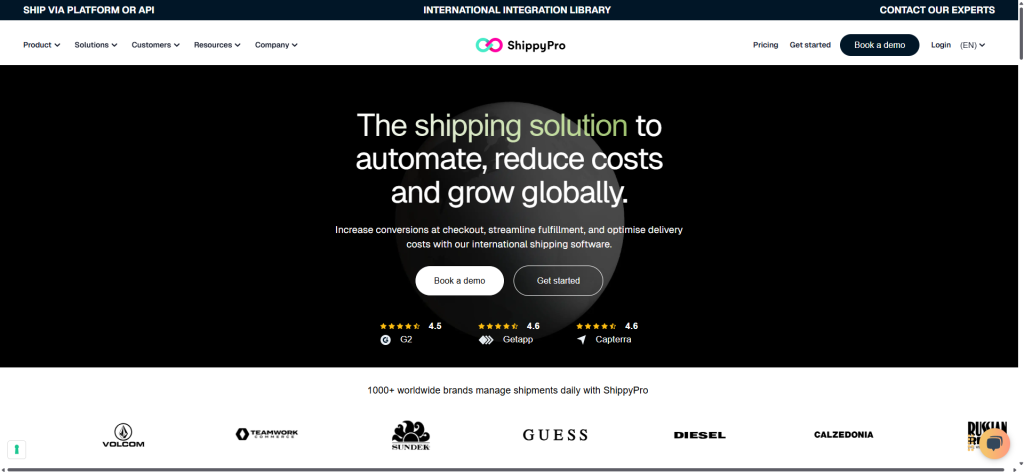
G2: 4.5/5
Starting price: $107/month
ShippyPro is another eCommerce shipping software that can streamline your shipping operations. Integrated with 180+ carriers and 80+ channels, ShippyPro is ideal for enterprise businesses that handle high daily shipping volumes.
Key Features
- Label creator: generates shipping labels and manages fulfillment operations across multiple carriers and channels.
- Track & Trace: provides real-time tracking information and delivery status updates to customers.
- Optimizer: analyzes shipping data and automatically selects optimal carrier and service combinations.
- Rate comparison: compares shipping rates across different carriers and helps access discounted shipping rates through carrier partnerships.
- Ship & Collect®: displays available pickup points and delivery options during the checkout process.
- Easy Return®: manages return processes, including return label generation and return tracking functionality.
Pros
- Seamless integrations with popular eCommerce platforms
Cons
- Expensive and fixed plan
How to Migrate from AfterShip to TrackingMore Quickly?
Ready to make the switch to TrackingMore? Here’s your step-by-step roadmap to migrate without disrupting your current operations.
Step 1: Export Your Data from AfterShip
AfterShip lets you export your tracking history, customer preferences, and integration settings. Download everything you might need later.
TrackingMore’s data formats fully comply with international logistics standards, so it is simple to import data directly and maintain compatibility.
Some data exports take time to process, especially if you have thousands of shipments. Start this process early so you’re not waiting around when you’re ready to move forward.
Step 2: Map Carrier Codes
Compare the carrier codes used in AfterShip and TrackingMore. Most major global carriers have nearly identical codes, but double-check for discrepancies to prevent data mismatch.
| Carrier | AfterShip Code | TrackingMore Code |
|---|---|---|
| USPS | usps | usps |
| UPS | ups | ups |
| DHL | dhl | dhl |
| FedEx | fedex | fedex |
| Royal Mail | royal-mail | royal-mail |
Step 3: Import and Integrate in TrackingMore
Set up your carrier integrations, webhook endpoints, and notifications. Customize your new tracking page to match your brand and set up email and SMS templates that fit your voice and style.
Use TrackingMore’s import tools to load your data. Data formats are international-standardized, ensuring smooth compatibility.
Timeline expectations: Most businesses complete their data switchover on TrackingMore within several hours.
Step 4: Connect Your eCommerce Stack
Connect your eCommerce platform, email tools, and other software before you start tracking any orders. This prevents gaps in your workflow.
Test each integration with a dummy order. Make sure data flows correctly between systems. It’s much easier to fix connection issues now than after you’ve got live orders running through the system.
Step 5: Run A Parallel Test for One Week
Process new orders through both AfterShip and TrackingMore simultaneously. This lets you compare performance and catch any issues.
During this week, customers still use your tracking service, so there’s no disruption to their experience. Meanwhile, you can see how TrackingMore handles your actual order volume and patterns.
Step 6: Migrate Over During Low-traffic Periods
Pick a time when you typically have fewer orders coming in. Weekend mornings or specific weekdays often work best, depending on your business.
Step 7: Monitor Closely for the First 48 Hours
After migrating formally, keep an eye on customer support tickets, system performance, and integration stability. Most issues surface within the first two days.
Fortunately, with TrackingMore’s 24/7 technical support and comprehensive developer tools, you can count on a smooth and worry-free migration experience.
Conclusion
Better shipment tracking transforms your customer experience. Fewer support tickets, happier customers, and smoother operations follow naturally.
Use the 5 considerations we covered to evaluate these 10 AfterShip alternatives based on your specific business needs. Your perfect solution is in this list.
The TrackingMore team shares insights on logistics tracking technology, industry trends, and e-commerce logistics solutions to help businesses streamline shipment tracking and enhance customer post-purchase experience.